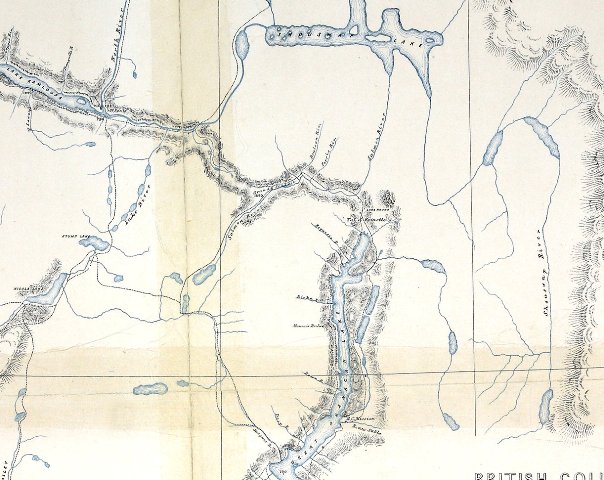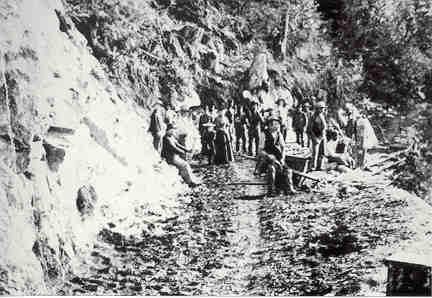
The World in 1862

The Monashee Almanac is an online journal that shares history, mysteries and stories about early British Columbia and in particular the Monashee, Okanagan and Shuswap.
Celebrating History, Mysteries & Stories
Economic Development
on a changing Planet in 1862
Extracts from the 1862 British Columbia Immigration Report
A colonial map of British Columbia dated 1862.
This image represents a detail of a larger map of the southen interior region. Note the Shuswap River and the Monashee Mountains on the far right.
Extracts from the Canadian Immigration Report of 1862
Insights about the people who entered Canada in 1862
These highlights provide an insight about the people who arrived and the fierce conditions they faced on their way to the new world.

When gold was discovered at Cherry Creek in 1862, the new colony of British Columbia was keeping careful immigration records and within them is a vast collection of information about how the colony was developing. This story represents a portion of the 1862 Immigration Report contained in the British Parliamentary Papers published in 1863 and filed as XV [3199], 247.
Sentence structure and spelling is retained within this presentation in order to give the reader an authentic experience as the document directly records the words of Governor James Douglas in 1862. This document was found archived within the University of Waterloo library.
According to the report, 1862 began with certain disadvantages, owing to the unprecedented duration and severity of the winter. On the 15th April Governor Douglas wrote his report on April 15, 1862.
1862 Immigration Report
by Governor James Douglas
The Fraser burst its frozen barriers a few days ago, sweeping before it the vast fields of ice which for nearly twelve weeks have rendered navigation impossible, and completely interrupted the communication by water with Vale and Douglas. The river steam boats are agin at work; the wants of the country are being rapidly supplied; trade is active, and the population generally full of hope and enterprise.
The accounts from Lytton and the districts east of the coast mountains are favourable beyond expectation; no disastrous floods have swept over the fair face of the country; the mountain roads are uninjured, and the loss of cattle does not exceed the ordinary casualties of winter."
On the breaking up of the winter a considerable immigration set in to the mining districts, and the small stocks of food were consumed faster than they could be replenished by the tedious and expensive process of packing on mule back. All kind of provisions consequently went up to famine prices, and hundreds of valuable labourers who had no money of their own and could not obtain employment, were compelled to leave the country in haste. The Governor estimates the loss to the revenue from these causes to two months collection. But it is satisfactory to find that the general revenue for the first three quarters of 1862 is stated approximately at 67,073£ against 47,000£ for the same period of 1861, shewing an increase of upwards of 20,000£ or more than 42 per cent.
The work of most importance last year was the commencement of two separate lines of carriage road, terminating at Alexandria, and intersecting the best farming districts of the country. One of these roads will connect Lillooet with the carriage road from Douglas, of which it is to be a continuation; starting from Lillooett[sic] it will follow the valley of the Fraser to Pavillon, and from thence to the Table Lane or Divide, which separates the waters of Bonaparte from the streams flowing directly into Fraser river, until it reaches William Lake, beyond which it will re-enter and follow the valley of the Fraser to the termination of the road at Alexandria.
The other line commences at Yale and follows the present mule road by the passes of the Fraser to Lytton; thence bending South and keeping the banks of Thompson river, it will enter the valley of Bonaparte a few miles from its dèbouche, and follow the course of that steam and the Table Land beyond it to Axe lake, and thence take a North-west course to William's Lake, where it will form a junction with the road from Lillooet, and continue on the same line to Alexandria.
From Alexandria upwards the country becomes more accessible for trade; the Fraser no longer retaining its dangerous character, becomes a smooth and navigable stream, presenting comparatively few obstacles to the navigator. Departing from the general North by West course, which it maintains from Hope upwards, one branch bends to the East at Fort George, and then stretching away in a South-easterly direction towards the rocky mountains, it incloses, as a base, the Carriboo district, thus forming a means of communication which will lessen the cost of mining operations, and greatly facilitate the progress of settlement.
The construction of the lines of road from Lytton to Alexandria and from Lillooet to Alexandria was let, under contract, to the largest commercial firms of the colony. A portion of the line from Yale to Lytton, about 50 miles, was undertaken by Government, the remaining portion constituting the most difficult section between Yale and Boston Bar, was assigned by contract to Mr. Joseph Trutch, said to be a gentleman of engineering ability. The works on the two lines, as well as on Mr. Trutch's section, were to be carried on at the cost of the contractors, aided by loans from the Government, the contractors being reimbursed exclusively by tolls, on which, however, the loans from a first charge. The portion of the work undertaken at the cost of Government has been completed. Mr. Trutch's section will not be completed till the spring, for the removal of one of the mountain shoulders, involving about 100,000 cubic feet of blasting in the solid rock, and upon which only a limited number of men can be simultaneously employed, cannot be earlier effected. Upon the line from Lytton to Alexandria, 45 miles of road are said to have been constructed in a creditable manner, at an outlay of 100,000 dollars; but the contractors found they had commenced a gigantic undertaking with inadequate means, and were compelled to relinquish it, throwing the road upon the hands of the Government when only half completed. From Lillooet towards Alexandria, 128 miles of road have been completed at an outlay of 190,000 dollars. In order to complete these works, it has been necessary to increase the loan from 50,000£ to 100,000£, the sum originally sanctioned; but it is calculated that the tools levied on the new roads will yield an income not only sufficient to pay the interest of the loan, but also to provide for the repayment of the capital.
As an illustration of the immediate gain to the revenue and enormous saving which will be effected in the cost of inland transport by the present work, the Governor mentions the following facts:--Up to the end of last summer, the lowest charge for carrying goods from Douglas by way of Lillooet to Alexandria was 61 cents per pound, or $1,366 per ton Now, in anticipation of the completion of the road, one of the most substantial carriers in the colony has lately tendered for the transport of all Government stores reuired in 1863 over the same line, at the rate of 21 cents per pound; that is, at a reduction of no less than 40 cents per pound, or 896 dollars per ton, as compared with the rate charged in 1862.
Again:-- By the returns of road tolls, it appears that 4,200 tons of goods have passed Yale, and Douglas in 1862 for the upper country. Assuming that, at a very low estimate, 1,000 tons were forwarded to Quesnel and Alexandria, and that a like quantity only will be taken up in 1863, the aggregate saving to the public by the reduction in the cost of transport at the rate before stated, would amount to no less a sum than 896,000 dollars.
The Lillooet Alexandria Road Tolls Act impose a charge of one halfpenny a pound on all goods passing over the new roads, and it is calculated that these tolls will yield a collective sum of 16,000£ for the year ending 31st December 1863.
In the course of September and October, Governor Douglas visited all the principal towns in British Columbia, and inspected the new roads, which, in smoothness and solidity, surpassed his expectation. He perceived a striking improvement in all the principal towns except Hope, which is almost deserted in consequence of the migration of the inhabitants to Carriboo and other places. The settlers are beginning to take up public land along the course of the public roads, and are turning their attention to tillage and stock raising.
Farm produce of all kinds fetches an enormous price, not at Carriboo only, but in the midland districts as well. Hay was selling in October last year at Lillooet and Lytton for 5d. a lb., or 46£ 13s. 4d. per ton. Barley at from 45s. to 75s. per bushel. Potatoes at 9½d. per lb., and garden stuffs of all kinds at the same rate.
Mining on the Fraser between Hope and Lillooet is now almost exclusively confined to Indians and Chinese. The same remark applies to Shimilkomeen, Rock Creek, and Thompson's River, which are forsaken by the white miners, who, as well as the newly-arrived emigrants, have almost to a man gone to Carriboo. Some valuable specimens of coarse gold have, however, been lately received from a party of miners on the Shimilkomeen River. Gold has also been discovered in the neighbourhood of Okanagan Lake, yielding on an average from seven to fifteen dollars a day per man. But for extent and richness of auriferous deposits there has yet been discovered no place at all to be compared with William's Creek, Carriboo, where last year the gold lead was reached at a depth of 40 and 60 feet, at about a quarter of a mile from the spot where it was before lost. It is therefore inferred that the lead is continuous for that interval, and that it may exist for an indefinite distance down the course of the stream. The yield of gold is stated to have averaged two thousand dollars per running foot of the lead.
We place in the Appendix an extract of a Report of Mr. Begbie, the judge of British Columbia, containing a very interesting and detailed account of the recent discoveries and mining operations in this district, from which it will be seen that claims are now taken up at William's Creek for a continuous extent of about five miles by several hundred feet in some places in width, and the lead has been discovered over so many points of this area as to make it quite certain that every claim will next year be thoroughly prospected before one claim is abandoned.
Where claims are worked by tunnel or shaft, a considerable amount of mining operations can be carried on all the year round, as these underground works are beyond the influence of frost and snow. But owing chiefly to the high price and scarcity of provisions, the great majority of the mining population leave Carriboo at the approach of winter, and the district may be said to be deserted for nearly seven months. The number of men remaining in Carriboo at the close of 1862 was only 350; of these 150 were on William's Creek, and the remainder in the southern part of the district. The Reports of the gold commissioners and district magistrates for December are favourable as to the condition and the prospect of the colony. The weather had been uniformly mild, and trade had suffered no interruption from frost and snow. The beef cattle and transport animals wintering at Sumass and in the Thompson and Bonaparte Valleys, preparatory to being sent to the mines, were doing extremely well, owing to the mildness of the season, though not housed, and suffered to roam at large.
This article contains the immigration highlights for Canada, as identified within the 1862 Immigration Report in the British Parliamentary Papers 1863 XV [3199], 247.
Extracts from the Canadian Immigration Report of 1862
Insights about the people who entered Canada in 1862
These highlights provide an insight about the people who arrived and the fierce conditions they faced on their way to the new world.
Number of immigrants was 22,176 of which 3,451 came from Norway and Sweden and 2,516 from Germany.
Of the 14,401 from the UK, 5,431 sailed from Liverpool; 3,308 from Londonderry; 2,855 from Glasgow and 872 from Cork.
Average length of voyage was 13¼ days from Liverpool and 18 from Glasgow. By sailing ship the time was 36 days and from the continent of Europe 50 days.
There were 7 deaths reported, one man, two women, and four infants on the vessels from the UK. "Of the Norwegians there died 184 on the passage and 42 in quarantine, making together 226, or more than four per cent of the whole number. Among the Germans, there died 77 at sea and 15 in hospital. The diseases which proved so fatal were small-pox, scarlet fever, and ship fever, fostered by the crowded state of some of the vessels, and by the absence, as it is alleged, of the most simple precautions for health."
"The number of persons aided to emigrate from the United Kingdom was 783, comprising 278 men, 340 women, and 165 children. Of these England supplied 358, Ireland 330, and Scotland 95.
The English consisted of 63 boys and 18 girls from reformatories, who easily found employment, and with few exceptions, conducted themselves well, 29 sent out under the poor laws, and 69 families, numbering 248 souls, from Bedworth and Coventry, whose passages were paid by public subscription. The heads of these families had all been more or less employed as agricultural labourers when unable to get work at their trade as ribbon makers, and being generally young and active, they had no difficulty in procuring work in Upper Canada as farm labourers.
Among the Irish there were 95 coopers, sent out by an association in Cork, 168 women and girls from the unions of Ballycastle, Balrothery, Carlow, Clonmel, Cork, Kanturk and Tullamore, 5 men and 13 women from the estates of Lord Palmerston in Sligo, and 49 from those of other private persons. The first got work on farms not being able to find employment in their own trade, which is differently carried on in the province and in this country. The women and girls from the unions were all strong and robust; they received 10s. each on landing, and were promptly located in country districts. The tenants of Lord Palmerston also found no difficulty in procuring employment, being an eligible class of immigrants. Thirty-two of the girls from Scotland were aided to emigrate by the Female Emigration Society of Edinburgh. They received each a dress and free passage, and engaged to repay the society half the cost of the passage out of their first earnings. They went out under the guardianship of two matrons, and were directed straight to Toronto, and all found places on their arrival. Sixty-three other persons were also helped by private individuals, and all were satisfactorily disposed of."
(30)

The first known photograph of road construction on the Cariboo Trail. This photo was believed to be taken in 1862